As a dog owner, it’s essential to understand dog body language and vocalizations regardless of their breed. Dogs may come in all shapes and sizes, but they all have their unique personalities and ways of communicating. Developing effective communication skills with your dog is crucial for strengthening your bond, promoting their well-being, and ensuring a happy and healthy relationship.
In this post, we’ll explore how to decipher your dog’s body language and vocalizations to better understand their communication. We’ll look at common cues that dogs display, such as tail position, ear position, and eye contact, and what they can tell you about your dog’s mood and intentions. We’ll also examine different types of vocalizations that your dog might make, including barking, whining, and growling, and what each one can indicate.
Additionally, we’ll discuss how breed characteristics can play a role in your dog’s communication and offer tips for recognizing and responding to breed-specific cues. And finally, we’ll share some strategies for improving your communication skills with your dog, such as spending quality time together and using positive reinforcement training techniques.
Whether you’re a seasoned dog owner or a new dog parent, this post is for you. Let’s dive in and learn how to better understand our furry friends!

Understanding Your Dog’s Body Language
As a dog parent, it’s important to understand your furry friend’s body language to interpret their mood and behavior accurately. All dogs communicate in a variety of ways, including through their body language. Here are some common body language cues displayed by dogs and what they mean:
- Tail Position: Your dog’s tail position can indicate their mood. A wagging tail held high suggests happiness and excitement, while a low or tucked tail may indicate fear, anxiety, or submission. A slow and gentle wag may suggest relaxation and contentment.
- Ear Position: Dogs’ ears can also give away a lot about their mood. If their ears are perked up and facing forward, they’re likely alert and interested in their surroundings. Drooping or flattened ears may indicate fear, anxiety, or submission. However, some dogs may have floppy ears that always hang low, so it’s essential to consider the context and other cues before making an assumption.
- Eye Contact: Your dog’s eye contact can also be a clue to their mood. Direct eye contact can indicate confidence and assertiveness, while avoiding eye contact may suggest fear or submission.
By observing your dog’s body language cues, you can get a better sense of their current mood and what they might be trying to communicate. It’s important to respond appropriately to these cues, whether it’s by giving your dog space if they’re feeling anxious or showing affection and praise when they’re feeling happy and relaxed.
In addition to observing your dog’s body language, it’s also helpful to be aware of your own body language and how it can impact your dog’s communication with you. Dogs are highly attuned to our body language, so try to maintain a calm and relaxed demeanor when interacting with your furry friend. By doing so, you’ll create a positive and stress-free environment for your dog.
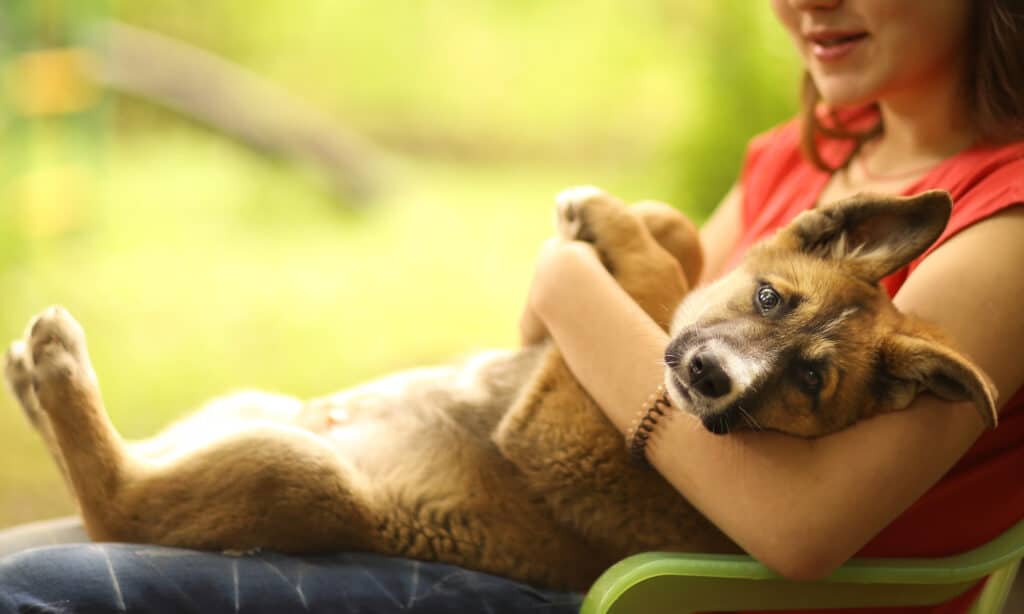
What Different Body Language Cues Mean and How To Respond To Them
Understanding your dog’s body language is essential for interpreting their mood and behavior. All dogs communicate through their body language, and it’s crucial to recognize common cues and what they might mean:
- Tail Tucked Between Legs: When a dog tucks their tail between their legs, it’s usually a sign of fear or submission. If you notice this body language, try to provide a calm and reassuring presence, speak in a soft tone, and avoid any sudden or threatening movements. This will help your dog feel safe and relaxed.
- Hackles Raised: When a dog’s hair along their back and shoulders stand up, it’s a sign that they’re feeling threatened or defensive. This body language is often accompanied by growling or barking. In this situation, it’s important to stay calm and avoid any sudden movements that could escalate the situation. Try to remove your dog from the source of the perceived threat or create a safe space for them to retreat to.
- Direct Eye Contact: If your dog makes direct eye contact with you, it’s usually a sign of confidence and assertiveness. This can be a positive sign, indicating that your dog trusts and respects you. However, be cautious if the eye contact is accompanied by tense body language, growling, or barking, as this could indicate a more aggressive posture.
- Yawning or Lip Licking: Dogs may yawn or lick their lips as a sign of stress or discomfort. If you notice your dog exhibiting these behaviors, try to provide a calm and reassuring presence, speak in a soft tone, and avoid any sudden or threatening movements. You may also want to consider removing them from the source of stress if possible.
By understanding and responding to your dog’s body language, you can strengthen your bond with them and promote their well-being. Remember to always approach your dog with a calm and reassuring demeanor and avoid any actions or movements that could be perceived as threatening or aggressive. With patience and understanding, you and your dog can communicate effectively and enjoy a happy, healthy relationship.
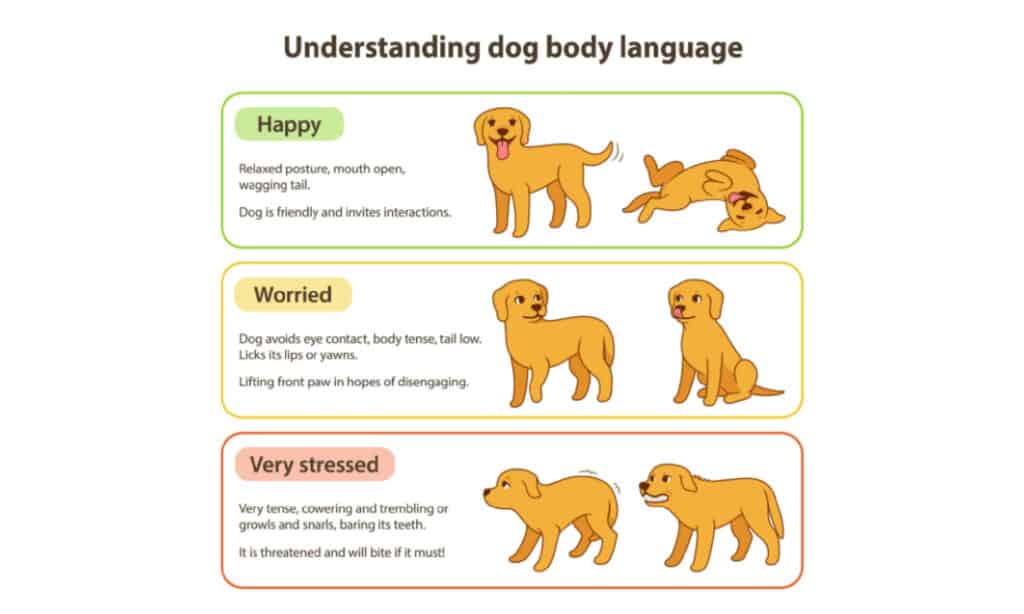
Tips For Observing Your Dog’s Body Language And Using It To Communicate Effectively
Observing your dog’s body language is a great way to better understand their communication and strengthen your bond with them. Here are some tips for observing your dog’s body language and using it to communicate effectively:
- Pay attention to their tail: Your dog’s tail can be a great indicator of their mood. Notice the position of their tail when they’re interacting with you or other dogs. A tail held high and wagging rapidly indicates excitement, while a tail tucked between their legs suggests fear or submission.
- Observe their eyes and ears: Your dog’s eyes and ears can also give you insights into their mood. Notice the position of their ears and the direction of their gaze. Perked-up ears and direct eye contact suggest alertness and interest while drooping ears and avoiding eye contact suggest fear or anxiety.
- Look for changes in posture: A change in posture can be a sign of a change in mood. If your dog goes from standing tall to crouching down low, they may be trying to communicate fear or submission. Conversely, if they go from a relaxed posture to a tense posture, they may be feeling threatened or defensive.
- Be aware of the context: The context in which your dog is exhibiting certain body language cues can also give you clues as to their mood. For example, if they’re exhibiting fear or anxiety in a certain location or around a certain person or dog, this could indicate that they’re uncomfortable with that specific situation or individual.
By observing your dog’s body language and responding appropriately, you can better understand their communication and promote a stronger bond. It’s important to approach your dog with patience and understanding and avoid any actions or movements that could be perceived as threatening or aggressive. With practice, you’ll become more adept at understanding your dog’s body language and communicating effectively with them.
Deciphering Your Dog’s Vocalizations
Understanding your dog’s vocalizations is crucial for responding appropriately and strengthening your bond with them. All dogs use vocalizations to communicate, and here are some tips for deciphering your dog’s vocalizations:
- Barking: Dogs bark for various reasons, and the tone and pitch of their bark can indicate their mood. A rapid or high-pitched bark may suggest excitement or happiness, while a deep, continuous bark could indicate anxiety or aggression. If your dog is barking excessively, it may be a sign that they need more physical activity or mental stimulation.
- Whining: Dogs may whine to communicate various emotions, such as anxiety, discomfort, or excitement. If you notice your dog whining excessively, it’s important to try and determine what might be causing their distress. This could be a physical ailment or separation anxiety.
- Growling: If your dog is growling, it’s typically a sign that they’re feeling defensive or threatened. It’s important to approach your dog with caution and to avoid any actions that could escalate the situation. You should also try to determine what might be causing your dog to feel defensive, such as another dog or a loud noise.
- Howling: Dogs may howl in response to certain stimuli, such as hearing sirens or other dogs howling. Additionally, howling can be a sign of separation anxiety if your dog howls when left alone.
Remember that understanding your dog’s vocalizations requires patience and careful observation. By paying attention to your dog’s tone, pitch, and volume, you can get a better sense of what they’re trying to communicate. Additionally, it’s important to approach your dog with patience and understanding and to avoid any actions that could be perceived as threatening or aggressive. With practice and observation, you’ll become better at deciphering your dog’s vocalizations and strengthening your bond with them.
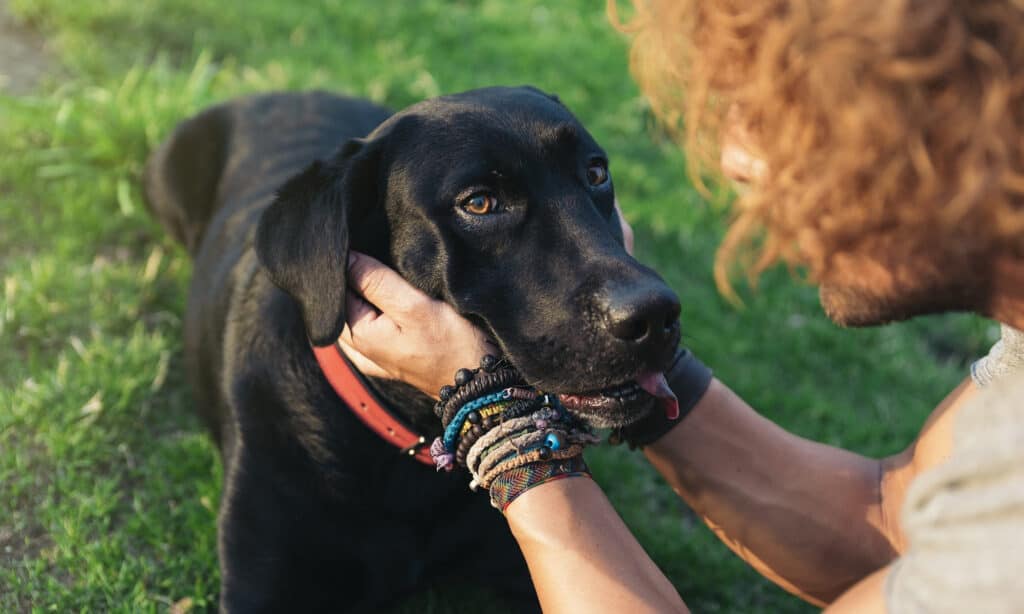
The Role of Breed-Specific Characteristics
Dogs of all breeds have unique personalities and ways of communicating that are influenced by their breed-specific characteristics. Understanding these traits can help you interpret your dog’s body language and vocalizations, and improve your relationship with them. Here are some examples of how breed-specific characteristics can impact your dog’s communication:
- Size and Physical Characteristics: A dog’s size and physical features can influence their posture, tail position, and other body language cues. For instance, if a dog is feeling threatened, they may try to appear larger by standing tall and raising their fur.
- Intelligence and Trainability: Different breeds have varying levels of intelligence and trainability, which can affect their communication style. Intelligent dogs may use certain commands and cues to communicate with their owners. Additionally, their quick learning abilities make training and communicating with them a rewarding experience.
- Temperament: A dog’s temperament can affect their body language cues, such as tail-wagging and playfulness when interacting with others. Some breeds are known for their friendly and affectionate personality, while others may be more reserved or protective.
It’s important to remember that each dog is unique and may exhibit different behaviors and communication styles. Therefore, it’s essential to observe your dog’s behavior closely and respond accordingly. Understanding your dog’s breed-specific characteristics can help you interpret their communication more accurately and build a stronger bond with them. By taking the time to understand your dog’s personality and behavior, you can create a positive and rewarding relationship with them.
Improving Communication with Your Dog
Every dog has a unique personality and way of communicating that can be influenced by their breed-specific characteristics. Understanding these traits can help you interpret your dog’s body language and vocalizations and improve your relationship with them. Here are some examples of how breed-specific characteristics can impact your dog’s communication:
- Size and Physical Characteristics: A dog’s size and physical features can influence their posture, tail position, and other body language cues. For instance, if your dog is feeling threatened, they may try to appear larger by standing tall and raising their fur.
- Intelligence and Trainability: Different breeds of dogs have varying levels of intelligence and trainability. A dog’s intelligence can affect their vocalizations, as they may use certain commands and cues to communicate with their owners. Additionally, their quick learning abilities make training and communicating with them a rewarding experience.
- Temperament: A dog’s temperament can affect their body language cues, such as tail-wagging and playfulness when interacting with others. Some dogs are known for their friendly and affectionate personality, while others may be more reserved or independent.
It’s important to remember that each dog is unique and may exhibit different behaviors and communication styles. Therefore, it’s essential to observe your dog’s behavior closely and respond accordingly. Understanding your dog’s breed-specific characteristics can help you interpret their communication more accurately and build a stronger bond with them. By taking the time to understand your dog’s personality and behavior, you can create a positive and rewarding relationship with them.
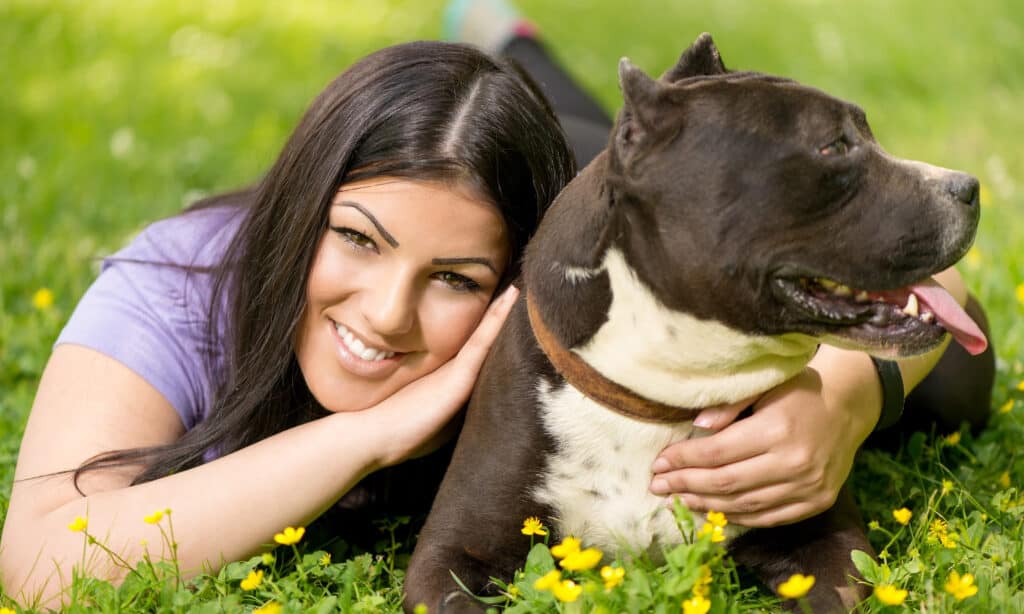
The Importance Of Developing A Strong Bond With Your Dog Through Effective Communication
As a dog owner, you know how important it is to develop a strong bond with your furry friend regardless of their breed. Effective communication is key to building this bond. Here are some reasons why it’s so important:
- Builds trust and understanding: When you communicate effectively with your dog, you build trust and understanding. This makes them more likely to follow your commands and exhibit desirable behavior, which strengthens your bond.
- Enhances your relationship: Effective communication helps you develop a deeper and more meaningful relationship with your dog. This leads to a stronger bond and a more enjoyable life for both you and your furry friend.
- Improves their mental and emotional health: A strong bond with their owner can improve a dog’s mental and emotional health. Effective communication can help reduce their anxiety, stress, and other negative emotions, leading to a happier and healthier pup.
- Prevents behavior issues: Effective communication can help prevent behavior issues such as aggression, barking, and destructive behavior. By communicating effectively with your dog, you can address any behavior concerns and prevent them from becoming bigger problems.
Remember, developing a strong bond with your dog takes time, patience, and effective communication. By observing their body language, using positive reinforcement, and spending quality time together, you can build a stronger and healthier relationship with your furry friend. This can lead to a happier and more fulfilling life for both you and your dog.
Tips For Improving Your Communication Skills
Improving your communication skills with your dog can help you build a stronger bond with them, regardless of their breed. Here are some tips to help you communicate more effectively:
- Listen actively: Active listening means paying attention to your dog’s body language and vocalizations and responding accordingly. This can help you better understand their needs and feelings, and improve your communication with them.
- Use clear and concise commands: Using clear and concise commands makes it easier for your dog to understand what you want them to do. This can help prevent confusion and improve their response to your commands.
- Use positive reinforcement: Positive reinforcement is a powerful way to communicate with your dog. When they exhibit desirable behavior, reward them with praise, petting, or treats. This encourages them to repeat the behavior and strengthens your bond.
- Be patient and consistent: Effective communication with your dog takes patience and consistency. Be patient when teaching them new commands or responding to their cues. Consistency is also crucial, so be sure to use the same commands and reactions consistently.
- Understand their personality and communication style: Every dog is unique, and understanding their personality and communication style can help you communicate more effectively with them. By observing their body language and vocalizations, you can get a better idea of how they communicate and respond to different situations.
Improving your communication skills with your dog can take time and effort, but it’s well worth it. By listening actively, using clear commands, positive reinforcement, being patient and consistent, and understanding their personality and communication style, you can improve your communication skills and build a stronger bond with your furry friend.
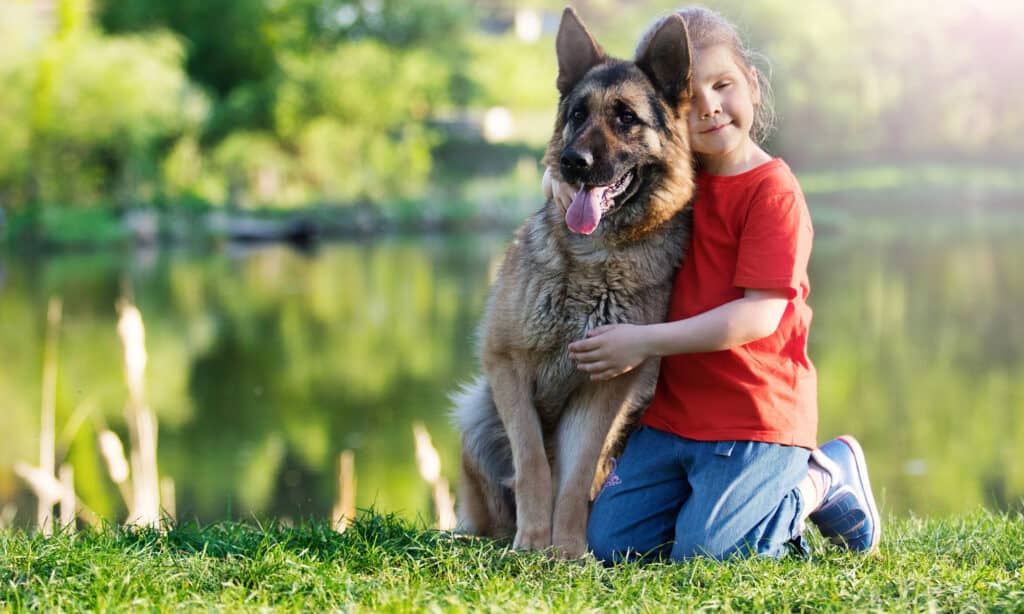
Using Positive Reinforcement Training Techniques
Positive reinforcement training is a powerful tool for communicating with your dog. Here’s how it works and how to use it effectively:
What is Positive Reinforcement Training?
Positive reinforcement training is a training method that focuses on rewarding desirable behavior rather than punishing undesirable behavior. When your pup exhibits desirable behavior, you reward them with praise, treats, or other positive reinforcement. This encourages them to repeat the behavior in the future.
How To Use Positive Reinforcement Training With Your Dog:
- Identify desirable behavior: The first step in positive reinforcement training is identifying desirable behavior that you want your Schnoodle to exhibit. This could be anything from sitting on command to staying calm during a visit to the vet.
- Reward desirable behavior: When your Schnoodle exhibits the desirable behavior, immediately reward them with praise, petting, or treats. This reinforces the behavior and encourages them to repeat it in the future.
- Be consistent: Consistency is key to effective positive reinforcement training. Be sure to reward desirable behavior every time it occurs, and use the same commands and reactions consistently.
- Avoid punishment: Positive reinforcement training focuses on rewarding desirable behavior, rather than punishing undesirable behavior. Avoid punishing your Schnoodle for undesired behavior, as this can create fear or anxiety and damage your bond with them.

Conclusion
In conclusion, effective communication is essential for building a strong and healthy relationship with your dog. By observing their body language, using positive reinforcement, and practicing active listening, you can improve your communication skills and create a more fulfilling life together.
Remember, every dog is unique, so understanding their personality and communication style is crucial for effective communication. By developing a strong bond through effective communication, you can improve their behavior, happiness, and well-being.
Improving your communication with your dog takes time and effort, but it’s well worth it. By being patient, consistent, and observant, you can build a stronger bond with your furry friend and enjoy a more rewarding relationship. So start improving your communication skills today and see the positive changes it can bring to your life with your pup!
~Lindsie
